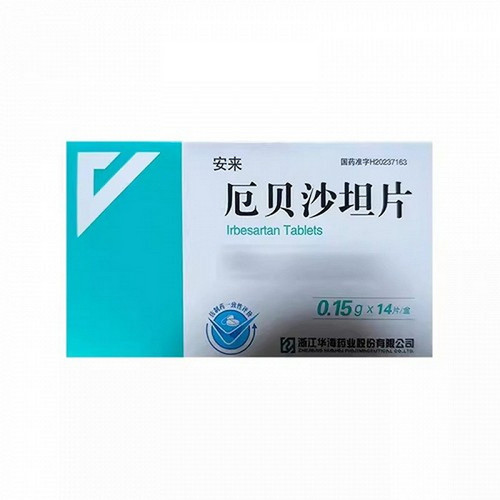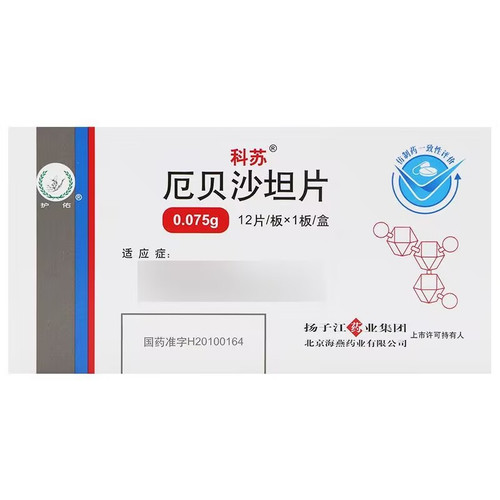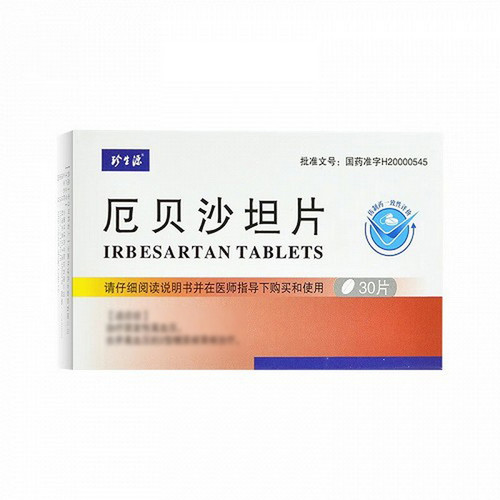Product Overview
[Drug Name]
Generic Name: Irbesartan Tablets
Trade Name: Anlai
English Name: Irbesartan Tablets
Chinese Pinyin: Ebeishatan Pian
[Ingredients]
Irbesartan.
[Properties]
This product is white or off-white tablets.
[Indications]
Hypertension.
[Dosage and Administration]
Oral.
1. The recommended starting dose is 0.15g once daily. Depending on the condition, it can be increased to 0.3g once daily.
2. It can be used alone or in combination with other antihypertensive drugs. For severe hypertension or when blood pressure remains unsatisfactory after increasing the dose, a low-dose diuretic (such as a thiazide) or other antihypertensive drug can be added.
[Adverse Reactions]
Common adverse reactions include headache, dizziness, palpitations, and occasional cough. These are generally mild and transient, and most patients can tolerate continued medication. Urticaria and angioedema are rare. Adverse reactions reported in the literature with an incidence greater than 1% include: dyspepsia, heartburn, diarrhea, musculoskeletal pain, fatigue, and upper respiratory tract infection, but no significant difference was observed compared with the blank control group. Adverse reactions reported with an incidence greater than 1% but lower than the control group include abdominal pain, anxiety, nervousness, chest pain, pharyngitis, nausea and vomiting, rash, and tachycardia. The incidence of hypotension and orthostatic hypotension is approximately 0.4%.
[Contraindications]
This product is contraindicated in patients with allergies.
[Precautions]
Volume depletion and/or sodium deficiency should be corrected before starting treatment. See the package insert for details. Please read the package insert carefully and use as directed by your doctor.
[Use in Special Populations]
Precautions for use in children: The safety and efficacy of Ambovi in children have not been established.
Precautions during pregnancy and lactation: 1. As a precautionary measure, it is best not to use this product during the first trimester of pregnancy. 2. This product is contraindicated in pregnant women from the fourth to ninth month of pregnancy. 3. This product is contraindicated during lactation. Elderly Precautions: Although a starting dose of 75 mg may be considered for patients over 75 years of age, dose adjustment is generally not required for elderly patients.
[Drug Interactions]
1. Diuretics and Other Antihypertensive Drugs: When this product is used concomitantly with other antihypertensive drugs, its antihypertensive effect may be enhanced. However, this product can be safely used concomitantly with other antihypertensive drugs, such as long-acting calcium channel blockers, beta-blockers, and thiazide diuretics. High-dose diuretics used prior to the initial use of this product may increase volume depletion and the risk of hypotension. Potassium Supplements and Potassium-Sparing Diuretics: Based on clinical experience with other drugs that affect the renin-angiotensin system, the concomitant use of potassium-sparing diuretics, potassium supplements, potassium-containing salt substitutes, or other drugs that increase serum potassium levels (e.g., heparin sodium) can lead to increases in serum potassium and is therefore not recommended. 2. Lithium: Reversible increases in serum lithium and toxic effects have been reported when lithium is used concomitantly with angiotensin-converting enzyme inhibitors. Furthermore, thiazide diuretics can reduce renal clearance of lithium, and similar effects have rarely been reported with the use of this product. Therefore, concomitant use is not recommended (4.4). If this product is to be used with lithium, careful monitoring of serum lithium concentrations is recommended. 3. Nonsteroidal Anti-inflammatory Drugs: Like other drugs with antihypertensive properties, the antihypertensive effect of irbesartan may be attenuated by nonsteroidal anti-inflammatory drugs. 4. Additional Information on Drug Interactions: In healthy male subjects, the pharmacokinetics of digoxin were not altered when coadministered with 150 mg of irbesartan. The pharmacokinetics of irbesartan were not affected when coadministered with hydrochlorothiazide. Irbesartan is primarily metabolized by CYP2C9, with a lesser extent by glucuronidation. Inhibition of the glucuronyltransferase pathway does not result in clinically significant interactions. In vitro interactions have been observed between irbesartan and warfarin, tolbutamide (CYP2C9 substrates), and nifedipine (CYP2C9 inhibitor). However, no significant pharmacokinetic or pharmacodynamic interactions were observed when irbesartan was coadministered with warfarin in healthy male subjects. The pharmacokinetics of irbesartan were not affected when coadministered with nifedipine. The effects of CYP2C9 inducers, such as rifampicin, on the pharmacokinetics of irbesartan have not been studied. Based on in vitro data, no interactions are expected with drugs whose metabolism is dependent on the cytochrome P450 isoenzymes CYP1A1, CYP1A2, CYP2A6, CYP2B6, CYP2D6, CYP2E1, or CYP3A4.
[Pharmacological Action] 1. Irbesartan is a potent, orally active, selective angiotensin II receptor (AT1 subtype) antagonist. It should block all angiotensin II effects mediated by the AT1 receptor, regardless of the source or synthetic pathway of angiotensin II. Its selective antagonism of the angiotensin-II receptor (AT1) results in increased plasma renin and angiotensin-II levels and decreased plasma aldosterone levels. When administered alone at the recommended dose, irbesartan does not significantly affect serum potassium in patients without electrolyte imbalances. 2. Irbesartan does not inhibit angiotensin-converting enzyme (ACE-kininase II), which generates angiotensin-II, nor does it degrade bradykinin into inactive metabolites. 3. Irbesartan's activity does not require metabolic activation. There was no evidence of unusual systemic or target organ toxicity at clinically relevant doses. In preclinical safety studies, high doses of irbesartan (≥250 mg/kg/day in mice and ≥100 mg/kg/day in rhesus monkeys) resulted in decreases in red blood cell parameters (red blood cell count, hemoglobin, and hematocrit). At very high doses (≥500 mg/kg/day), irbesartan can induce renal degeneration in rats and rhesus monkeys (e.g., interstitial nephritis, tubular swelling, and elevated plasma urea nitrogen and creatinine concentrations), believed to be secondary to the drug's hypotensive effect, which may lead to renal hypoperfusion. Furthermore, irbesartan can induce proliferation and hypertrophy of the juxtaglomerular apparatus (at doses of ≥90 mg/kg/day in rats and ≥10 mg/kg/day in rhesus monkeys). All of these changes are believed to be due to the pharmacological effects of irbesartan. At therapeutic doses of irbesartan used in humans, proliferation/hypertrophy of juxtaglomerular apparatus cells is not associated with irbesartan.
Storage: Store in a dry place below 30°C.
Specifications: 75 mg x 12 tablets
Packaging: Box
Expiry Life: 36 months. Approval Number: National Medicine Standard H20030016
Manufacturer: Zhejiang Huahai Pharmaceutical Co., Ltd.







